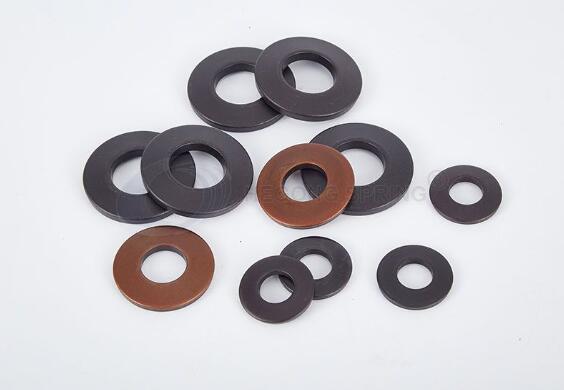Spring washers, sometimes called disc springs, are a subtype of washers. They lend their mechanical capabilities to the unique profile of the material: when subject to a load, the irregularities of the washer compress with a proportionate resistance to return to their predeflected shape. Spring washers are employed in applications where assemblies need a part to take up play, eliminate rattle, maintain assembly tension, compensate for expansion or contraction in materials after assembly, or to absorb intermittent shock loads and provide a controlled reaction under dynamic loads.
1. Belleville washers, also known as cupped spring washers or conical washers, have a slight conical shape, which provides an axial force when deformed.
2. A curved disc spring is similar to a Belleville, except the washer is curved in only one direction, therefore there are only four points of contact. Unlike Belleville washers, they exert only light pressures.
3. Wave washers have a “wave” in the axial direction, which provides spring pressure when compressed. Wave washers, of comparable size, do not produce as much force as Belleville washers. In Germany, they are sometimes used as lock washers, however they are less effective than other choices.

Spring washer operation is dependent on the elastic deformation of it's material, which should have good tensile strength and elastic limits. A high fatigue limit is not a product of the material, but can be enhanced by the use of quality metals with a smooth, carbon-free surface.
● Steel is the most common material for spring washers due to its ease of process and its high tensile strength. Chrome vandium alloy is a higher quality steel with a good through-hardening capability; it is used to make very thick spring washers. Specialty washers offering corrosion resistance include steel-nickel alloys. High-temperature applications incorporate chrome-molybdenum into the material structure to create washers that can operate over 400°C.
● Copper alloys offer non-magnetic yet electrically conductive washers, along with some corrosion resistance. These alloys have lower strength values than steel.
● Nickel-chrome and nickel-chrome-cobalt alloys have very high tensile strengths with very low elastic ratios. These washers will have more set if overloaded, but they have extreme longevity and corrosion resistance. They can also operate in a large range of temperatures, from absolute zero to over 700°C. These expensive alloys are difficult to manufacture.
Spring rate is the amount of load (lb./N) needed to move the spring a predetermined distance (in/mm). Spring force is the measurement of the resisting pressure resultant of a compressed spring washer. Manufacturers will usually specify this in their inventory. Both of these specifications are altered with the use of a spring stack, and spring force is directly dependent of how the load is distributed on the washer.
Spring washers can be used as a type of lock washer to eliminate rattle or vibration that might unscrew a bolt. These are common in instances where a coil spring would be impractical or too large. Disc springs are common on pipe flanges to combat flange leakage from high temperatures and varying pressure. These small devices are also found in many types of valves and pumps, braking systems, types of couplings, machine presses, aerial cable cars, boiler suspension systems, and overload protection components in electrical transformers. Not until the 1930s did the disc spring become prominent, when formulas to calculate disc springs were developed pre-World War II in the United States. As such, the spring washer was used in anti-tank mines and artillery guns.
If you want to know more information about spring washers, please feel free to contact us.